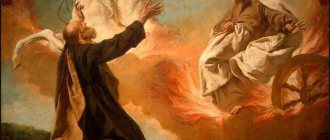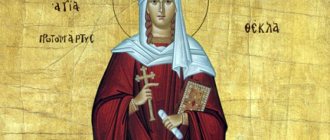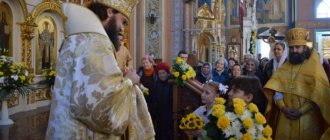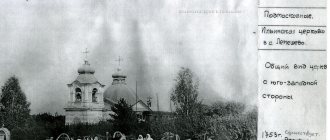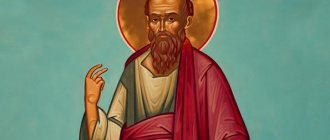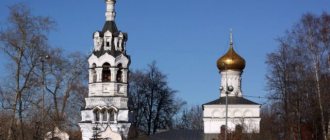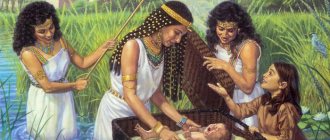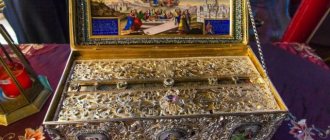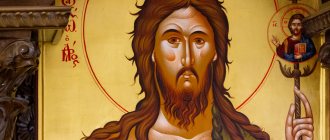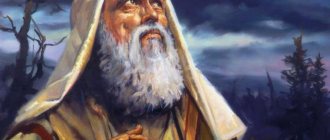| Holy Prophet Elijah. Icon of the mid-15th century, Novgorod. State Tretyakov Gallery. |
Elijah the Tishbite
(IX century BC), one of the greatest prophets and the first virgin of the Old Testament Memory July 20
Born in Thesbia of Gilead in the tribe of Levi in the 9th century. BC. The life of the holy prophet is described in the 3rd and 4th books of Kings.
Saint Epiphanius of Cyprus reports the following legend about the birth of the prophet Elijah: “When Elijah was born, his father Sovakh saw in a vision that handsome men greeted him, swaddled him with fire and fed him with a fiery flame.”
The name Elijah given to the baby, which means “the strength of the Lord” [1], determined his entire life. From an early age he devoted himself to the One God, settled in the desert and spent his life in strict fasting, contemplation of God and prayer.
Called to prophetic service under the Israeli king Ahab, the prophet became a fiery zealot for true faith and piety. At that time, the Israeli people fell away from the faith of their fathers, abandoned the One God and worshiped pagan idols, the veneration of which was introduced by the wicked king Jeroboam. The wife of King Ahab, the pagan Jezebel, especially supported idolatry, planting the worship of the idol Baal throughout the land. Seeing the death of his people, the prophet Elijah began to denounce King Ahab of wickedness, urging him to repent and turn to the True God, but the king did not listen to him. Then the prophet Elijah announced to him that, as punishment, there would be no rain or dew on the earth for three years and the drought would end only through his prayer.
And indeed, through the prayer of the prophet, the sky closed, and drought and famine occurred throughout the entire earth. The people suffered from unbearable heat and hunger. The Lord, in His mercy, seeing the suffering of the people, was ready to spare everyone and send rain to the earth, but did not want to violate the words of the prophet Elijah, who was burning with the desire to turn the hearts of the Israelis to repentance and return them to true worship of God. Preserving the prophet Elijah from the hands of Jezebel, the Lord, during a time of disaster, sent him to a hidden place in the desert near the stream Cherith. From the stream the prophet quenched his thirst, and the Lord commanded the predatory crows to bring food to the prophet, thereby instilling in him pity for the suffering people.
When, a year later, the stream of Horath dried up, the Lord sent the prophet Elijah to Zarephath of Sidon to a poor widow who suffered with her children in anticipation of starvation. At the request of the prophet, she prepared him unleavened bread from the last handful of flour and the rest of the oil. Then, through the prayer of the prophet Elijah, flour and oil from then on did not run out in the widow’s house throughout the famine. During his two years of staying in her house, by the power of his prayer, the great prophet performed another miracle - he resurrected the dead son of this widow.
| Elijah the prophet in the desert |
After three years of drought, the Merciful Lord sent a prophet to King Ahab to end the disaster.
Elijah ordered all Israel and the priests of Baal to gather on Mount Carmel. He announced to the king and the people that all the misfortunes of the Israelites were due to the fact that they had forgotten the true God and began to worship the idol Baal. To prove the error of the Israelites, Elijah proposed making two altars - one to Baal and the other to God. “The God who gives the answer through fire is God” (1 Kings 18:24), he said. The priests of Valla were the first to begin the sacrifice: they made an altar, piled up firewood, slaughtered the calf and cried out to the idol from morning to evening, but in vain - the sky was silent. In the evening, the holy prophet Elijah erected his altar of 12 stones, according to the number of tribes of Israel, laid the sacrifice on the firewood, ordered a ditch to be dug around the altar, and ordered to water the sacrifice and firewood with water. When the ditch was filled with water, the fiery prophet turned to God with a fervent prayer and petition, so that the Lord would send fire from heaven to admonish the erring and embittered Israeli people and turn their hearts to Himself. Through the prayer of the prophet, fire came down from heaven and burned the sacrifice, wood, and even stones and water. The people, having seen the miracle, believed in Him again and fell to the ground, crying out: “The Lord is God!” Then the prophet Elijah stabbed all the priests of Baal and began to pray for the sending of rain. Through his prayer, the sky opened and abundant rain fell, watering the thirsty earth. King Ahab realized his error and mourned his sins, but his wife Jezebel threatened to kill the prophet of God. The prophet Elijah fled to the kingdom of Judea and, grieving over his powerlessness to eradicate idolatry, asked God for his death. But an Angel of the Lord appeared to him, strengthened him with food and commanded him to go on a long journey. The prophet Elijah walked for forty days and nights and, having reached Mount Horeb, settled in a cave. Here, after a terrible storm, earthquake and flame, the Lord appeared to him “in the still wind” and revealed to the grieving prophet that He had preserved seven thousand faithful slaves who did not worship Baal. The Lord commanded the prophet Elijah to anoint Elisha, his heir, to the prophetic ministry.
After Mount Horeb, the ministry of Saint Elijah continued for several more years. Sent by God, he went to Damascus to anoint Hazael as king in Syria, and Jehu as king in Israel. By the will of God, Elijah found Elisha near the village of Abel-Mecholy and anointed him as a prophet.
For his fiery zeal for the glory of God, the prophet Elijah was taken “as if into heaven” alive in a chariot of fire. The prophet Elisha witnessed the ascension of the prophet Elijah and received, along with his fallen mantle, the gift of a prophetic spirit twice as great as the prophet Elijah had. Since, according to the word of the Lord, “no one ascended into heaven except the Son of Man who came down from heaven, who is in heaven” (John 3:13), Saint Elijah was thus transferred by the angels to another hidden place, where since then remains until the time of his second appearance [2].
Prophet Elijah. Biography
The Prophet Elijah was born in Thesbia of Gilead in the tribe of Levi 900 years before the birth of Christ. According to the legend that has come down to us from Saint Epiphanius of Cyprus (d. 403), when Elijah was born, his father had a mysterious vision: handsome men welcomed the baby, swaddled him with fire and fed him with a fiery flame. The name of the prophet Elijah is translated as “My God is the Lord,” which expresses the main content of his ministry (1 Kings 18.36) - a zealous struggle for the worship of the one God and who demonstrated His power through his deeds.
The Prophet Elijah was a zealous champion of the purity of faith in the kingdom of Israel and a formidable denouncer of idolatry and wickedness. His activity dates back to the reign of Ahab (d. 852 BC), when his Phoenician wife Jezebel decided to establish the cult of Baal and Ashtoreth. Tradition says that the true zealots of piety were expelled from the country, and a staff of priests of Baal was established at court. The prophet Elijah appeared as a terrible accuser of the trampling of the shrine, who performed many miracles to admonish the wicked king. The history of his life and work is set out in the Third and Fourth Books of Kings (1 Kings 17-20 and 2 Kings 1-3).
When Ahab's wickedness reached its limit, the prophet Elijah announced to the king that because of his wickedness, the country would suffer famine for several years (1 Kings 17:1). But Ahab did not repent; a struggle began between the king and the prophet, ending in the triumph of the latter. During the sacrifice on Mount Carmel (Carmel), arranged for the purpose of testing and comparing the power of Yahweh and Baal, the priests of the latter suffered a complete defeat and were executed by the prophet (1 Kings 18:40). This further angered Jezebel, who vowed to kill Elijah. At the direction of God, the prophet Elijah hid near the stream Horath, where ravens brought him food every morning and evening.
The people at that time suffered from unbearable heat and hunger. The Old Testament legend tells that the Lord, in His mercy, seeing the suffering of people, was ready to spare everyone and send rain to the earth, but did not want to violate the words of the prophet Elijah. It was important for the prophet to turn the hearts of the Israelites to repentance and return them to true worship of God. After some time, the prophet Elijah, according to the word of God, went to Zarephath of Sidon to visit a poor widow. Because she did not spare the last handful of flour and oil, through the prayer of the prophet Elijah, flour and oil have not been exhausted in the widow’s house since then. Here the prophet Elijah performed another miracle: he revived the widow’s suddenly ill and dead son, sympathizing with the woman’s grief.
In the third year of drought, the prophet Elijah returned to Ahab. Elijah proposed a contest with the priests of Baal to find out whose god was true. Having gathered the people on Mount Carmel, the prophet Elijah proposed to build two altars: one from the priests of Baal, the other from the prophet Elijah to serve the True God. “On which of them fire falls from heaven, that will be an indication whose God is true,” said the prophet Elijah, “and everyone will have to worship Him, and those who do not recognize Him will be put to death.” The priests of Baal danced, prayed and stabbed themselves with knives all day, but nothing happened. In the evening, the prophet Elijah erected his altar of 12 stones, according to the number of tribes of Israel, laid the sacrifice on the firewood, ordered a ditch to be dug around the altar, and ordered the sacrifice and firewood to be watered. When the ditch was filled with water, the fiery prophet turned to God with a fervent prayer and petition, so that the Lord would send fire from heaven to admonish the erring and embittered Israeli people and turn their hearts to Himself. Fire fell from the sky and ignited the sacrifice of the prophet Elijah. The people exclaimed: “Truly the Lord is One God, and there is no other God besides Him!” Then, by order of the prophet Elijah, the priests were killed. Through the prayer of the prophet Elijah, the Lord sent abundant rain to the earth, and the drought ended. However, despite the miracles and great signs that happened through the prayer of the prophet, Jezebel wanted to kill him because he put the priests of Baal to death. Elijah disappeared into the desert.
At this time, the prophet was honored, as far as possible for a person, to contemplate God face to face. The Lord consoled him, saying that there were still people on earth who had never worshiped idols, and pointed Elijah to Elisha, whom He chose as a prophet after Elijah.
According to legend, the prophet Elijah was taken to Heaven alive:
Suddenly a chariot of fire and horses of fire appeared, and separated them both, and Elijah rushed into Heaven in a whirlwind (2 Kings 2:11).
According to the Bible, before him, only Enoch, who lived before the Flood, was taken alive into heaven (Gen. 5:24). In the Book of Wisdom of Jesus, son of Sirach, the event of the ascension of Elijah is described as follows:
Elijah was hidden by a whirlwind, and Elisha was filled with his spirit (Sirach 48:12).
According to the Fourth Book of Kings, Elijah left his outer garment (“mantle”) for the prophet Elisha, having thrown it to him from the chariot of fire (2 Kings 2:11-13).
The Book of Malachi says that God will send the prophet Elijah back to earth:
Behold, I will send you Elijah the prophet before the coming of the great and terrible day of the Lord (Mal. 4:5).
We are talking about the Second Coming here. Before the Second Coming, the prophet Elijah will descend from heaven to expose the false Messiah and convert the remnant of Israel to the true God.
The prophet Elijah is mentioned several times in the New Testament. Thus, an episode is described how the elders and people asked John the Baptist, when he preached on the banks of the Jordan in the spirit and power of Elijah and even looked like him in appearance, was he not Elijah? Also, the disciples of Jesus Christ, according to the Gospel of Matthew, asked Him if Elijah should come before the Messiah. To which Christ replied: “True, Elijah must come first and arrange everything; but I tell you that Elijah has already come, and they did not recognize him, but did to him as they wanted; so the Son of Man will suffer from them” (Matthew 17:11-12). Then the disciples realized that Jesus was talking about John the Baptist, who was beheaded (Mark 6:28).
During the Transfiguration of the Lord, the prophet Elijah appeared with Moses, and they talked with Jesus “about His exodus, which He was about to accomplish in Jerusalem” (Luke 9:31). According to John Chrysostom, “one who died and another who has not yet experienced death” appeared in order to show that “Christ has power over life and death, rules over heaven and earth.” He is supposed to be one of the two lamps standing before God and must appear before the Second Coming of Christ to earth (Rev. 11:3-12). During the suffering of Christ on the cross, some of the people thought that Christ was calling the prophet Elijah for help, and expected his arrival.
Preacher of the One God
Contemporary to Elijah, King Ahab of Israel and his wife Jezebel were idolaters: they made sacrifices to the pagan deity Baal (Jezebel came from the Phoenicians who worshiped him, and was herself a priestess) and persuaded the people to do so. Elijah openly denounced the king and queen, thereby earning the hatred of the latter.
As punishment for the king’s persistence in idolatry, the Lord sends heat to the country. For three years there was no rain or dew from the sky. The drought stopped only through the prayer of Elijah, which put the priests of Baal to shame.
This happened under the following circumstances.
Elijah gathered the people of Israel and the priests of Baal on Mount Carmel and proposed to build two altars - to God and to Baal - and to offer sacrifices on them, but not to set it on fire. If Baal burns his victim with fire from heaven, then he is the true God. If the Lord is the true God, He is.
Baal, of course, “did not accept” his sacrifice. God burned not only the sacrifice, but also the firewood, the stone altar, and even the ditch with water, which, by order of Elijah, surrounded the altar.
The people of Israel repented and praised God, and Elijah personally killed all the priests of Baal as those who seduced people. After this, he prayed to the Lord for rain, and the Lord respected his prayer.
Miracles of the Holy Prophet Elijah
Through the prayer of the prophet Elijah, the sky “closed up” and did not give rain (1 Kings 17:1), which is why there was a famine. According to the word of God, food was brought to him by ravens (1 Kings 17:6) and an angel (1 Kings 19:5-6). According to the word of the prophet, the food in the house of the widow of Sarepta did not end (1 Kings 17:13-16). The prophet Elijah resurrected the boy of the Sarepta widow (1 Kings 17:21-22). The prophet Elijah brought down fire on the altar (1 Kings 18:36-38). Through the prayer of the prophet, God gave rain to the earth after a three-year “confinement” of heaven (1 Kings 18:41-45). The prophet Elijah spoke with God face to face, while covering his face (1 Kings 19:9-14). The Prophet Elijah brought down fire from heaven, both to punish sinners and as a sign of true worship of God (2 Kings 1:10-12). The prophet Elijah divided the Jordan River like Moses, striking it with his robe (2 Kings 2:8). The prophet Elijah was taken up alive into heaven for his special righteousness before God (2 Kings 2:11).
Elijah in Judaism
The tradition of the prophet Eliyahu as the forerunner of the Moshiach (Messiah) existed in ancient, pre-Christian Judaism, and it continues to this day. Moreover: it is believed that Elijah will not only return to earth before the coming of the Messiah, but will also anoint him as king (since there can be no other indication other than directly from God through the prophet to a legitimate king after a centuries-long break in dynasties).
Jewish tradition also claims that Eliyahu visits the home of every family celebrating Passover (the commemoration of the exodus from Egypt) - therefore, during the ritual Passover meal, a glass is left on the table for the prophet.
Veneration of the Prophet Elijah in Rus'
The Prophet Elijah was one of the first saints of God who began to be revered in Rus'. In his name, even under Prince Askold, at the beginning of the 9th century, a cathedral church was erected in Kyiv. And the holy Equal-to-the-Apostles Princess Olga built a church in the name of the prophet of God Elijah in the north of Rus', in the village of Vybuty. The Holy Prophet Elijah has always been perceived by the Orthodox Russian people as one of the saints closest to our fatherland. in the “ Ilyinsky ” churches, especially during drought. Elijah's day was considered the boundary of the seasons, while among the southern Slavs (for example, in Macedonia) this day was called the middle of summer, and in Russia - the turn to winter. After Ilyin's day, rain was expected, and it was forbidden to swim (so as not to drown or get sick). On this day one could begin to enjoy the fruits of the new harvest. The holiday was associated in the ideas of the Slavs with the theme of marriage and the symbolism of fertility: they prayed for a rich harvest, and girls prayed for getting married.
The day of remembrance of the Prophet Elijah is celebrated on August 2 (July 20, old style). In Christianity, he is the most revered Old Testament saint. Based on his birthplace in the city of Thisbah , the prophet Elijah is called Elijah the Tezbite.
Israel in the darkness of paganism
900 years before the birth of Jesus Christ, the wicked king Jeroboam reigned in Israel. For reasons of self-interest, he abandoned the true God, fell into idolatry and carried away the entire unfortunate people with him. Since then, a whole galaxy of kings of Israel worshiped idols. The inhabitants of the country suffered many troubles because of their wickedness. But the Lord, in His boundless mercy, did not abandon the apostates, but tried to return them to the true path, sending them prophets and denouncing paganism through their mouths. Among them, the most ardent fighter for the true faith was the prophet of God Elijah.
Troparion, kontakion and canon to the holy prophet Elijah
Troparion, tone 4.
Carnal ѓngl, and 3rd prophetic degree. the second part of the coming of Christ, and the glorious ones. From above I sent grace to the foxes, to drive away illnesses, and to cleanse the lepers. In the same way, those who honor є3go2 t0read the goals2.
The carnal angel, and the prophet of the degree, the second forerunner of the coming of Christ, the glorious Elijah, having sent Elisha’s grace from above, to drive away illnesses, and to cleanse lepers, with the same ones who honor him, he sharpens healing.
Kontakion, tone 2.
Moreover, you have foreseen great deeds of ours, and 3 your great name, and by broadcasting your 1st water-flowing clouds, pray 2 to us 3rd person.
Prophet and seer of the great deeds of our God, Great Elijah, whose broadcasting decrees and water-flowing clouds, pray for us to the One Lover of Mankind.
Library of the Russian Faith Canon to the Prophet Elijah →
Read online
The descent of heavenly fire on the servants of King Ahaziah
After Ahab, his son Ahaziah reigned. Like his father, he worshiped Baal and other pagan gods. And then one day, having become seriously ill, he began to call on them for help. Having learned about this, the Prophet Elijah angrily condemned him and predicted his imminent death. Twice the angry king sent detachments of soldiers to seize Elijah, and twice fire came down from heaven and destroyed them. Only the third time, when the messengers fell on their knees before him, did the Prophet have mercy on them. After Elijah repeated his diatribe, Ahaziah died.
Holy Prophet Elijah. Icons
Images of the Prophet Elijah were as widespread as the images of St. Nicholas the Wonderworker, the Great Martyrs George the Victorious and Demetrius of Thessalonica. The iconography of the prophet Elijah combines symbolic elements that reflect his significance as a participant in the most important events in the history of the divine economy. The words of St. John Chrysostom contain a vivid figurative description of the prophet:
Let us imagine... Elijah, a prophet, an earthly angel and a heavenly man, who walked the earth and drove a heavenly chariot, who was three cubits tall and reached to a great height, who rose to the very vaults of heaven, the lord of the waters, whose tongue was the repository of the waters and the key of heaven (John Chrysostom, St. The Tale of the Apostle Peter and the Prophet Elijah // Creations. 2004. Vol. 2. Book 2. P. 776).
In Christian art, not only individual images of the prophet Elijah were common, but also individual scenes from his Life. When venerated, Elijah was endowed with various functions. For the monks, his life was an example of ascetic deeds. Among the imperial circles he was revered as the patron of military valor. Emperor Basil I of Macedon every year, on the day of memory of Elijah, attended a service in the New Church of the Great Imperial Palace, where Elijah's mantle and belt were kept. In popular perception, Elijah was the patron of the elements. The role of the prophet-god-seer in the divine economy, the eschatological expectations of Elijah as the herald of the Second Coming, as well as various aspects of his veneration became the reasons for the diversity of iconography.
There are known images of the prophet Elijah in the Jewish synagogue in Dura Europos (249-250). In the scene with the king, judging by the fragments of the legs, the prophet was presented frontally. A fragmentary image of legs has been preserved near a strip of land, possibly the remains of the figure of the general Obadiah , who led Elijah to Ahab . In the scene of the resurrection of the son of the Sarepta widow, Elijah reclines on a bed, in his arms is a baby, whom he extends to the hand of the Lord, depicted above, on the left is the preliminary action - a widow in black clothes gives Elijah the body of her dead son, on the right - a widow in light festive clothes holds in the arms of a cheerful baby.
The earliest depiction of the prophet Elijah is represented in the iconography of the Ascension of the Prophet Elijah, or the Fiery Ascension , and is found in the Chapel of Sant'Aquilino in the Basilica of San Lorenzo Maggiore in Milan (c. 370 n.). In the apse of the Basilica of Sant'Apollinare in Classe in Ravenna (c. 549) in the scene of the Transfiguration of the Lord (the figure of Christ is replaced by a cross with His face in the middle cross, the apostles Peter, John and James are presented in the form of lambs, the cross is in the pose of an orant Bishop Apollinaris, flanked by 12 apostles in the form of lambs) half-figures of the prophets Elijah (right) and Moses (left) are represented in the clouds. Elijah is an old man with long, gray hair, parted in the middle and falling down his back, with a long gray beard pointed downwards.
The earliest known icon image of Elijah was made using the technique of wax painting (encaustic) in the 7th century and is located in the monastery of the Great Martyr Catherine in Sinai. The icon was the right wing of a triptych that has not survived. Elijah is depicted as gray-haired, his clothes are detailed with an assist. The right hand is in a prophetic gesture, and the lowered left hand holds an unfolded scroll.
Prophet Elijah. Icon. VII century Monastery of the Great Martyr Catherine in Sinai
Rare examples of single images of Elijah have been preserved in Byzantine art. One of the earliest is a large icon (1180-1200, Byzantine Museum, Kastoria) with a cross-sectional frontal image of Elijah on a blue background, dressed in an ocher tunic with a blue belt and a mantle, with an unrolled scroll in his left hand. On a folding medallion with images of Our Lady Oranta and Jesus Christ (late 10th - early 11th centuries, National Library of St. Mark, Venice), Elijah is presented with a scroll in his hand among the prophets, apostles and saints.
The iconographic programs of temples of the Middle Byzantine period often included individual scenes from the Life of Elijah. The earliest examples include the frescoes of the cave church of Ayvali Kilise (Cappadocia; between 913 and 920), where on the slopes of a small arch framing a niche with the scene of the “Sacrifice of Abraham”, “The Sacrifice on Mount Carmel” and “The Ascension of the Prophet Elijah” are presented. .
Prophet Elijah. Fragment of a fresco from the Church of the Forty Martyrs in Tarnovo. OK. 1230 Regional Historical Museum, Veliko Tarnovo
The special veneration of the prophet Elijah on Sinai, not far from which, on Mount Horeb, he was honored to see God, led to the widespread dissemination of his images in various icons originating from the monastery of the Great Martyr Catherine or created for him.
Prophet Elijah. Second half of the 12th century. Monastery of St. Catherine, Sinai, Egypt
The Mother of God and Child with the prophets Moses and Elijah and St. Gregory the Theologian. OK. 1250s Monastery of St. Catherine, Sinai, Egypt. It is possible that what is depicted on the right is not St. Gregory the Theologian, but St. Nicholas the Wonderworker
The most widespread subjects in monumental art and icon painting are “The Prophet Elijah in the Desert” and “The Fiery Ascent of the Prophet Elijah.”
Elijah the Prophet, fed by a raven. 1199 Church of the Savior on Nereditsa, Novgorod. Fresco in the arcosolium of the altar apse
Detailed hagiographical narratives in monumental painting have been known since the 13th century. One of the earliest surviving cycles is located on the northern wall of the southeastern compartment of the temple in Akhtala (1205-1216) and includes 3 scenes: “The Sacrifice on Mount Carmel”, “The Prophet Elijah in the Desert”, “The Ascension of the Prophet Elijah”.
The first Christian church built in Kyiv was consecrated in the name of the prophet Elijah. Along with the traditional corpus of the Lives of Elijah and Eulogies, a cycle of apocryphal works appeared early in Rus'. Thus, in Russian indices, starting with the Izbornik of Prince Svyatoslav in 1073, there is an indication of the apocryphal “ Ilina’s addition ” (Agapius’s Walk to Paradise), where Elder Agapius’ guide through the Garden of Eden was Elijah. In “ The Word and Vision of the Apostle Paul ” (“The Apostle Paul’s Walk through Torment”) we talk about the meeting of the Apostle Paul with Elijah and Elisha in paradise. These works, despite being included in the category of prohibited books, were in demand at different times and became the source of new iconographies of the prophet Elijah.
Elijah the Prophet in the desert with his life and deesis. From the Church of Elijah the Prophet in the village of Vybuty near Pskov. Late XIII - early XIV centuries. State Tretyakov Gallery, Moscow
Prophet Elijah. From the prophetic order. Lavrentyev Andrey, Derma Ivan Yartsev. Novgorod, 1509 Hagia Sophia, Novgorod
Elijah the Prophet. First half - mid-15th century. Museum of Fine Arts of the Republic of Karelia, Petro src=»https://ruvera.ru/data/img/content/1498042045.1353prorok_iliya_9.jpg» class=»aligncenter» width=»800″ height=»1065″[/img] Elijah the Prophet . Novgorod. Late XIV - early XV centuries. State Tretyakov Gallery, Moscow
Prophet Elijah. Novgorod. XV century Comes from the village of Vorobyovo near Mashozero, Prionezhsky district of the Republic of Karelia
Elijah the Prophet. From the village of Keftenitsy in Karelia. XVI century State Russian Museum, St. Petersburg
Prophets Elijah and Elisha. From the prophetic order. Last third of the 16th century. Yaroslavl Art Museum, Yaroslavl
In Kievan Rus, the veneration of the prophet Elijah acquired peculiarities. The comparison of Elijah with the Archangel Michael, which appeared early in various iconographic versions, is characteristic of Old Russian culture and unusual for Byzantium. One of the reasons for the combination of the images of Elijah and the Archangel Michael was that both have power over the fire and water elements, and are also revered as intercessors for the human race at the Last Judgment. An early example of images of Elijah was preserved in the Kondakara Typographical Rules (late 11th - early 12th centuries, Tretyakov Gallery).
The earliest image in ancient Russian monumental art is known in the painting of St. Sophia of Kyiv, where the gray-haired Elijah is presented full-length, with a rolled scroll in his hand in the lower zone on the southwestern dome pillar.
The fiery ascent of Elijah the Prophet. XIV century State Historical Museum, Moscow
The diversity of the iconography of “Prophet Elijah in the Desert,” which contains a Eucharistic theme and expresses the ideal of monastic life, in Russian art was complemented by motifs of submission to God’s will, in-depth prayer, and at the same time bold and zealous communication with God. A few monuments of the 15th century depict Elijah sitting on a stone half-turned to the right, with his left hand supporting his head and a scroll in his right.
Elijah the Prophet in the desert. Novgorod. First half of the 15th century Museum of Fine Arts of the Republic of Karelia, Petro src=»https://ruvera.ru/data/img/content/1498042252.6242prorok_iliya_15.jpg» class=»aligncenter» width=»800″ height=»1113″[/img] Elijah the Prophet in a desert. Yaroslavl. End of the 15th century Yaroslavl Art Museum, Yaroslavl
Elijah the Prophet in the desert. First third - second quarter of the 16th century. Collection of V. A. Bondarenko, Moscow
Elijah the Prophet in the desert. XVI century Comes from a church in the village of Volosovo near Kargopol, Plesetsk district, Arkhangelsk region. State Russian Museum, St. Petersburg
Elijah the Prophet in the desert. Veliky Ustyug (?). XVI century State Museum of Palekh Art, Palekh
Elijah the Prophet in the desert. OK. 1530. Comes from the Church of Elijah the Prophet in the Tsypinsky churchyard, located near the Ferapontov Monastery. Kirillo-Belozersky Historical, Architectural and Art Museum-Reserve, Kirillov
Elijah the Prophet in the desert. Belozerye (?). Second half of the 16th century. Central Museum of Ancient Russian Culture and Art named after. Andrey Rublev, Moscow
Obviously, even in pre-Mongol Rus', parallels were traced between Elijah, taken to heaven in a pillar of fire, and the image of the Mother of God “The Burning Bush,” which are united by the theme of divine fire, transforming, but not scorching.
In the 16th century, the iconography of the “Fiery Ascent” began to be saturated with images of previous events from the Life of Elijah. On a Novgorod icon of the second quarter of the 16th century. There are two plots: “ An angel prompts Elijah ” and “ Crossing the Jordan on dry land .” As a result, iconography, which combines several compositions without dividing them into brands, became widespread and took shape in a special type of hagiographic icons. This phenomenon is unique to the iconography of Elijah. These “complex” compositions did not receive a special name and are named, as a rule, according to the plot, highlighted by scale.
Fiery ascent of the prophet Elijah. Novgorod. Second quarter of the 16th century. (1530s) Private collection at the Foundation of the Holy and All-Praised Apostle Andrew the First-Called, Moscow
The fiery ascent of Elijah the Prophet. Russian North. XVI century State Historical Museum, Moscow
Fiery ascent of the prophet Elijah. Second half of the 16th century. Comes from the Goritsky Monastery on Sheksna. State Tretyakov Gallery, Moscow
The fiery ascent of the prophet Elijah, with his life. Last quarter of the 16th century. Yaroslavl Historical, Architectural and Art Museum Reserve, Yaroslavl
Fiery ascension of Elijah the Prophet. Russian North. End of the 16th century Central Museum of Ancient Russian Culture and Art named after. Andrey Rublev, Moscow
Fiery ascent of the prophet Elijah. Novgorod. Beginning of the 17th century Icon Museum, Recklinghausen, Germany
The fiery ascent of the prophet Elijah, with his life. Panteleev Ignatius. Russian North (Obonezhye, Tubozero village), 1647. Museum of Fine Arts of the Republic of Karelia, Petrozavodsk
The earliest icon life cycle of the Prophet Elijah has been preserved in Russian art - the image “Prophet Elijah in the Desert, with Life” from the Vybuta churchyard near Pskov (beginning of the 13th century, Tretyakov Gallery). The centerpiece depicts Elijah in the desert, wearing apostolic robes - a tunic and a himation, without a raven.
Elijah the Prophet with his life. End of the 14th century Nizhny Novgorod Art Museum
The development of hagiographic iconography continued actively in the 16th century. Particular attention to the image of Elijah was explained by the spread of his veneration. Numerous “ordinary” churches in the name of the prophet Elijah are known.
Small-sized hagiographic icons of Elijah were intended for lecterns or for home prayer. Some of them had an individual selection of stamps, including rare subjects. For the Yaroslavl Church of St. Nicholas the Wonderworker, Semyon Spiridonov Kholmogorets painted the icon “ Prophet Elijah, with a life in 26 hallmarks ” (1678, Yakhm). Elijah is depicted full-length, with a scroll in his hand, in prayer to the Lord, in the heavenly segment on the left, with a sphere in his hands, sitting on cherubim. The composition of the centerpiece is enclosed in an arch against a background of exquisite herbs. The architecture and landscape in the hallmarks are unusually complex and varied.
Birth of a new prophet
The Bible says that he was born in the east of Palestine, in the city of Tishbit. At the moment of his birth, his father, a priest, had a vision: he saw some men swaddling the baby with fire and putting flame into his mouth. This was a prediction that in his mature years the words of his sermons would be like fire, and he would mercilessly burn out wickedness among his compatriots who had fallen into sin. They named the newborn Elijah, which translated from Hebrew means “my God.” These words perfectly expressed his destiny to become a vessel of God’s grace.
Growing up, the prophet Elijah, as befits the son of a priest, led a pure and righteous life, retiring for long periods into the desert and spending time in prayer. And the Lord loved him, sending down everything he asked. The young man himself grieved endlessly in his soul, seeing around him the terrible bacchanalia of idolatry. The rulers and people made human sacrifices. Everything was mired in vice and debauchery. The true God was forgotten. Before his eyes, those rare righteous people who still remained in Israel and tried to condemn the dishonor were put to death. Elijah's heart was filled with pain.
Temples of Elijah the Prophet in Rus'
In the name of the holy prophet Elijah, a church was consecrated in the Vybuta churchyard in the Pskov region . The stone Ilinskaya Church was built from a slab in the 15th century. Presumably, a more ancient temple stood here, because... in the Tretyakov Gallery in Moscow there is an icon of the holy prophet Elijah from the church in Vybuty, dated to the 13th century. The church stands on the banks of the Velikaya River. The bell tower is stone, in connection with the vestibule of the church. There are two altars in the church: the main one is in the name of the holy prophet of God Elijah, the side altar is in the name of St. Nicholas. There is a cemetery near the church. The church was closed during Soviet times. On December 15, 1927, the financial department of the Pskov regional executive committee sent a letter to the district department of public education (OKRONO) marked “Not subject to disclosure,” in which it announced its intention to “sell to Gospromtsvetmet 14 bells of different sizes from the closed Vybut Church.” In response, OKRONO said that “the sale of bells of non-museum significance can only be carried out by Glavnauka.” During the Great Patriotic War, the church was damaged. In 1955-1957 it was restored according to the design of V.P. Smirnova. In 1999, services were resumed in the church.
Temple in the name of the holy prophet Elijah at the Vybuta churchyard
In the name of the prophet Elijah, a temple was consecrated near the village of Konechek (formerly Krivovichi churchyard) in the Pskov region. There is no information available about when and by whom the church was built. In 1877, on the right side of the main church, a chapel was built in the name of the Holy Life-Giving Trinity. The church is surrounded by a cemetery, surrounded by a stone fence. The Ilyinskaya Church of the former Krivovichi churchyard was badly damaged during the military operations to liberate Pskov in 1944. Its ruins are located near the village of Konechek, Pskov region.
A temple in Warm Rows in Moscow was consecrated in the name of the prophet Elijah . The stone temple was built as a cathedral of the Ilyinsky Monastery, founded no later than the 15th century, next to the Moscow shopping area. From the name of this temple, Ilyinka Street was named, and the market began to be called Ilyinsky Sacrum. The construction of the temple was carried out from 1519 to 1521, “and it was built by ordinary people by someone named Klim, and nicknamed Muzhilo.” The church burned in 1547 and was damaged in a fire in 1626. The uprising of the townspeople on May 27, 1606 in Moscow against False Dmitry I began after the sound of the alarm on the bell tower of the monastery church of Elijah the Prophet, made on the orders of Shuisky. During the Time of Troubles, the monastery was abolished, the church became a parish church, and in 1676, along with the church land, it was transferred to the Novgorod bishop's house and was built as an upper church, where the throne was moved in honor of the Prophet Elijah. The ancient lower temple was consecrated in the name of the Apostle Timothy. The temple was closed in 1923, then the upper tier of the bell tower was dismantled. From 1930 to 1980, various institutions were located in the temple building. The building is a cultural heritage site of federal significance. Since 1995, services have resumed in the temple.
Temple of the Prophet Elijah in Warm Rows (Moscow)
was consecrated in honor of the prophet Elijah . Prussians of the Kolomensky district of the Moscow region . The Prussian village was owned by the Sheremetev boyars. In the middle of the 16th century, the Bishop of Kolomna acquired it. At the same time, the tented Elias Church was built. It is mentioned in stone in the scribe books of 1578. The building was partially remodeled in the 1660s. In the first half of the 19th century, a brick refectory and a wooden bell tower “on pillars” were added to the west (now lost).
Elijah Church in the village. Prussians
Also in the name of the prophet Elijah, the church at the Vyya churchyard in the Arkhangelsk region , which was built in 1600, was consecrated.
Elias Church at the Vyya churchyard
Elias Church existed in the village of Chasovenskaya (Zadnaya Dubrova) in the Arkhangelsk region. Built and consecrated around 1622. In 1879 it was dismantled and a new temple was built on the stone foundation. In 1884, the bell tower was dismantled to its foundations and rebuilt on a stone foundation. During the Soviet years, the altar was sawed off and the tent was brought down. It is in disrepair.
King Ahab's New Sin
Meanwhile, the wicked King Ahab again entered the path of sin. He liked the vineyard of an Israeli named Naboth, but when he tried to buy it, the king was refused. His proud heart could not bear such shame. Having learned about what had happened, Queen Jezebel, through her minions, slandered Naboth, accusing him of cursing both God and the king. The crowd stoned the innocent man, and Ahab became the owner of the vineyard. But his joy was short-lived. The Lord, through the mouth of His prophet Elijah, denounced the slanderer and predicted a quick death for him and his deceitful wife. Once again the king shed tears of repentance. Three years later he was killed. His wife and children survived the wicked man for a short time.
Old Believers and Edinoverie churches in the name of the prophet Elijah
In honor of the Prophet Elijah, a church of the Russian Orthodox Church in the village of Elkino, Voskresensky district, Moscow region, was consecrated. A wooden one-domed church with a hipped bell tower, built in 1907–1909 by reconstructing an old wooden prayer house on the first floor. XIX century, was closed in 1937 and later broken down. In 2005, a community of believers was re-established, and in 2007–2008 a new wooden single-domed church was built.
Elijah Church (RPsC) in the village of Elkino
Elias churches of the Russian Orthodox Church also exist in Gomel (Belarus), in the village. Zamulta, Ust-Koksinsky district, Altai Territory, in the village of Kavkazskaya, Krasnodar Territory, in the village. Toikino, Perm region, in the city of Veliky Novgorod, in the city of Naberezhnye Chelny, in the village. Praguri and Constanta (Romania).
Temple in the name of the prophet Elijah in Gomel
Elijah Church in the village. Toikino, Perm region
Elijah Church in Veliky Novgorod
Also, the RDC Church in the name of the Prophet Elijah is being built in the village of Plaskinino, Ramensky district, Moscow region. There is a temple in the name of the holy prophet Elijah the Fezbite in the city of Tbilisi, Tbilisi diocese of the Georgian Ancient Orthodox Church.
In Minsk (Belarus) there is a community of the same faith in the name of St. Prophet Elijah the Tezbite, founded in 2002.
Miracles in Sarepta
The next miracle performed was the salvation from starvation of a poor widow from the city of Zarephath, where Elijah went at the command of God. Because the poor woman did not spare the last piece of bread for him, her meager supplies of food became inexhaustible by God’s power. When the widow's son died of illness, the prophet Elijah, showing a new miracle, restored the boy's life. His name was Jonah. The Bible tells about his amazing fate. Having matured over the years, the young man became an ardent zealot of the true faith. One day, heading on a ship to the city of Nineveh, where he was going to appeal to the inhabitants with a call to repent, he got into a storm and ended up overboard, where he was swallowed by a whale. But by the will of God, three days later Jonah was thrown out alive and unharmed. This stay in the belly of the whale and subsequent return to the world is a prototype of Christ's three-day resurrection.
Holy Prophet Elijah. Paintings
The Holy Prophet Elijah was depicted on their canvases by famous artists such as Gillies van Koningslo, Peter Paul Rubens, Paul Gustave Doré, Julius Schnorr von Carolsfeld, A.M. Volkov, P. Pleshanov, P.I. Neradovsky and others.
Prophet Elijah and an angel in the desert. Peter Paul Rubens. 1626-1628 Bonn Museum, Bayonne
Raven feeding the prophet Elijah in the desert. Gillies van Koningsloe. End of the 16th century Royal Museum of Fine Arts. Brussels
Ascension of the Prophet Elijah. Paul Gustave Dore. OK. 1855–1866
Ascension of the Prophet Elijah. Julius Schnorr von Carolsfeld. OK. 1852–1860
Prophet Elijah resurrecting the son of the widow of Sarepta. A.M. Volkov. 1854 Taganrog Art Gallery
Resurrection of the son of the Sarepta widow. P. Pleshanov. 1854 State Russian Museum, St. Petersburg
Ascension of Elijah the Prophet to heaven. P. I. Neradovsky. Refectory with the Church of St. Sergius of Radonezh of the Trinity-Sergius Lavra. 1948
Elijah in Islam
The Prophet Elijah in the Islamic tradition is called by the name Ilyas. His biography briefly repeats the biblical biography of the prophet: he taught to worship the One God, and punished him for worshiping the idol Baal.
Some interpreters of the Koran and Islamic theologians believe that Idris (Enoch), Khidr (prophet - teacher of Moses, also immortal; there is no analogue in the Bible) are other names of Ilyas. The eschatological meaning that is invested in the figure of Elijah in Christianity and Judaism does not exist in Islam. But the belief that he was taken to heaven alive also exists in Islam - it is believed that he travels around the world with Khidr.
In later Islamic literature and legends, Ilyas generally becomes half-man, half-angel.
Folk traditions on Elijah's Day
On a fiery chariot, a mighty gray-haired old man with menacing eyes rides from end to end across the boundless heavenly fields, and his punishing hand rains fiery stone arrows from the heights above the stars, striking the frightened hosts of demons and sons of men who have transgressed the law of God. Wherever this formidable old man appears, he brings with him fire, horror, death and destruction. His unyielding heart will not be softened by the cries or groans of the afflicted, and the gaze of his menacing eyes will not stop at the sights of earthly misfortunes. Having fulfilled the justice of heaven, he, like a stormy whirlwind, rushes further and further on his sparkling chariot, and only gray curls scatter over his mighty shoulders, and a white, silver beard flutters in the wind. This, according to the views of the people, is the prophet Elijah, personifying the righteous wrath of God. Everywhere in Rus' he was called “formidable,” and everywhere the day dedicated to his memory was considered one of the most dangerous. In many places, peasants even fasted throughout Elijah Week in order to prevent the wrath of the prophet and save their fields, villages and livestock from his arrows. The peasants called the very day of the holiday “angry” and spent it in complete idleness, since even empty work was considered a great sin. If clouds appeared in the sky on this day, the people watched them with fear; if it came to a thunderstorm, then this fear turned into panic: the entire population hid in their houses, closed the doors tightly, curtained the windows and, lighting Thursday candles in front of the icon, begged the prophet to surrender his anger to mercy. In some regions, for example, in Nikolsk, Vologda province, peasants fumigated their house with incense in the evening, and all light objects, such as a samovar, a mirror and the like, were either covered with linen, or even taken out of the hut, on the grounds that the prophet Ilya considers such items a reprehensible luxury, indecent in peasant life. In the Vyatka province, the prophet Elijah was propitiated with gifts: on this day, peasants brought to the church a leg of ram, bee honey, beer, ears of fresh rye and green peas. But there was disagreement on the question of which of these items most pleased Ilya. Some stood for bee honey, others argued for the superiority of lamb.
Public prayers performed in the field were considered the most reliable means of preventing Elijah’s anger. In many villages such prayers were performed annually. Attributing to the prophet Elijah the power to produce thunder and lightning and direct clouds at his own discretion, that is, putting into his hands the most terrible and at the same time the most beneficial forces of nature, our people firmly believed that the fertility of the earth is the work of the prophet, and that without his will it is impossible maybe a harvest. Therefore, the people imagined Elijah not only as a messenger of heavenly wrath, but also as a benefactor of the human race, giving the earth an abundance of fruits and driving away evil spirits. According to popular belief, not only Elijah himself is terrible for evil spirits, but even the rain that fell on his day has great power: with Elijah’s rain they washed themselves from enemy slander, from attacks and enchantments. Elijah himself instilled panic, boundless horror into the demons: as soon as the roar of his chariot was heard in the sky, the devils ran in crowds to the boundaries, hid behind the backs of people or took refuge under the caps of poisonous mushrooms, popularly known as “yaruiki”.
There are many legends and traditions about the prophet Elijah. In almost every village you can listen to a story about some exceptional manifestation of the prophet’s wrath or mercy, about some miracle or heavenly sign: in almost every volost, in every district and province one could encounter new versions of old legends or come across a completely original legend of local origin. Here, for example, is what the peasants of the Oryol district and province told about the earthly life of the prophet Elijah: “Until the age of 33, the prophet Elijah sat and could not walk. His parents were poor people and uprooted stumps, feeding their crippled son with this work. One day the Lord walked along the earth with St. Nicholas the saint and, seeing Elijah, said: “Go, give us something to drink.” “I would be glad to give, but I can’t go,” answered Elijah. The Lord took him by the hand, and he rose from the ground himself. Then the Lord drew a full bucket of water from the well and told Ilya to drink, then he drew another one and half a third and asked him: “Well, how are you now?” “I can turn the whole world differently,” answered Elijah, “if there were a pillar in the middle of heaven and earth, I would destroy the whole earth.” Hearing these words, God was frightened and hastened to reduce Elijah’s strength by half and, moreover, ordered him to sit underground for 6 weeks. But then, when Elijah, having sat underground, came out into the light again (along with the prophet Onuphrius), the first thing he saw was the tomb. Elijah entered this tomb, and immediately a fiery chariot with angels descended from heaven, who rushed Elijah to heaven, presenting him before the face of the Lord. “You, Elijah,” said the Lord, “drive this chariot until I come to earth, and let thunder and lightning be in your hands from now on.” According to popular belief, on this chariot, Elijah, before the end of the world, will descend to earth and travel three times from one end of the earth to the other, warning everyone about the Last Judgment. This Oryol legend already varies in some places, and the peasants say that the Lord placed a stone of 40 dessiatines on Elijah’s head to reduce his strength. This stone is still intact and stands in heaven before the throne of God.
Considering the prophet Elijah to be the ruler of the winds and rain clouds, peasants associate many calendar signs with the day of this saint. “Before Elijah,” they say, “the clouds walk with the wind, but from Elijah they begin to walk against the wind.” “Before Elijah, the priest will not beg for rain, but after Elijah, the woman will catch up with an apron.” “After Ilya’s day,” the Vologda residents say, “you won’t see a horse in a field—that’s how dark the nights are.” “From Ilya’s day the night is long: the worker wakes up, and the horses eat enough.” “The water has been getting cold since Ilya’s day.” In the Poshekhonsky district of the Yaroslavl province, the reason for the cooling of river waters after Elijah’s day was explained as follows: “The Prophet Elijah rides horses across the sky, and from fast running one of the horses loses a horseshoe, which falls into the water, and the water immediately gets colder.”
Agricultural signs are also associated with the day of Elijah: “If on this day it is cloudy in the morning, then sowing should be early and a bountiful harvest can be expected; if it’s cloudy at noon, sowing is average, and if in the evening, sowing is late and the harvest is bad.”
Ilya in folklore
Due to the fact that, according to Elijah's prophecy, the heavens were closed for three years and rain fell on the earth through his prayer, Elijah is often associated with pre-Christian heavenly deities. Not the least role in these associations was played by the image of the prophet leaving for heaven - on a fiery chariot.
Already in the Christian era, in the fifth century, the poet Sedulius associated the Greek sun god Helios with the name Elijah, especially since both of these names are very close in sound (the name “Elijah” in Greek transcription sounds like “Elias”).
In the Slavic tradition, some functions of the pagan thunder god Perun were transferred to the figure of Elijah the Prophet. And the Komi people even introduced Elijah into the pantheon of their gods: Elijah the prophet is considered an assistant to one of the demiurge deities. His attributes are flint and steel, with which he strikes thunder and lightning.

